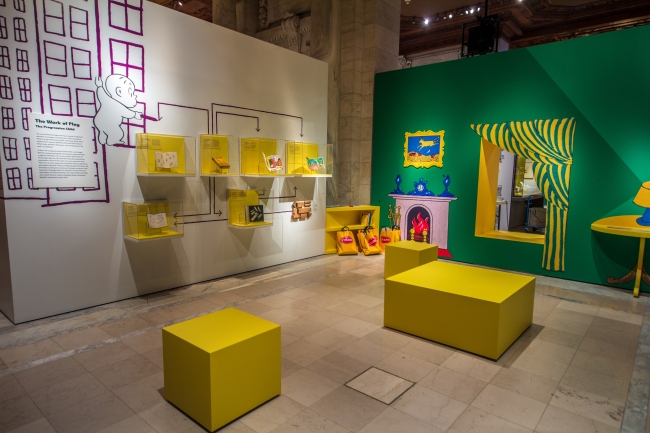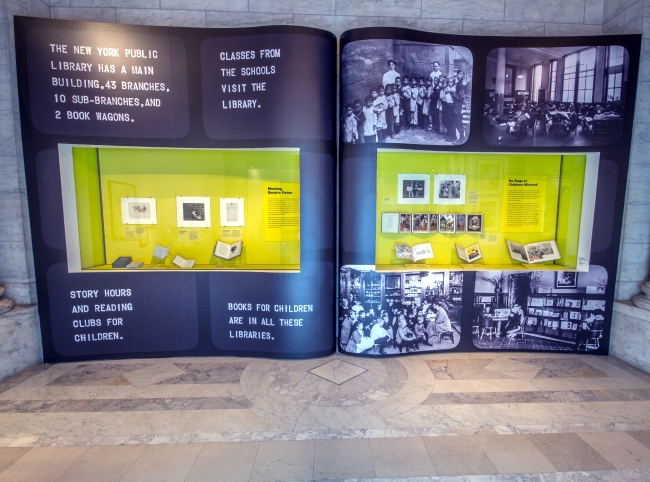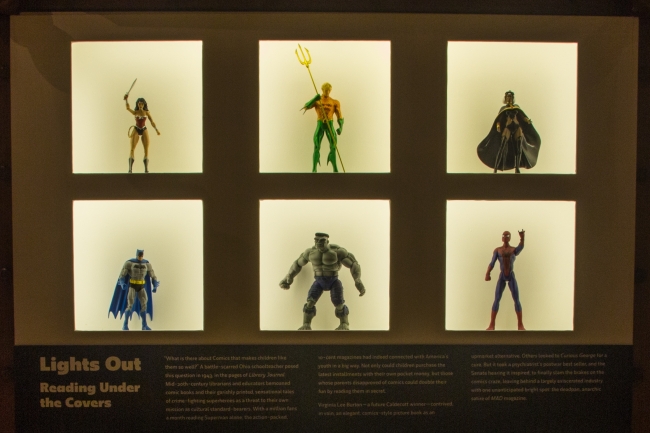Why Do Kids' Books Matter? Here, Look.
A New York Public Library exhibit tackles the historical, social, and artistic importance of reading materials meant for children over the centuries.

A good children's book is a young person's earliest exposure to art and design, a conduit for parental bonding, a means to teach individual and social lessons, and these days, possibly the last vestige of printed matter for the next digital generation as it weans itself from ink on paper to pixels on screens. All of these things become quite clear upon observing the New York Public Library's fittingly titled "The ABC of It: Why Children's Books Matter," curated by children's book historian Leonard Marcus. Recently opened, the show focuses on what makes kids' reads essential in art, culture, and in the overall imagination.
"I was told that I would have access to all the library's special collections, and that I could do pretty much anything I wanted," Marcus told me in an email. "I felt I had been handed the keys to the kingdom." And what riches that kingdom contains: the copy of Lewis Carroll's Alice's Adventures in Wonderland owned by Alice Liddell, the real-life model for Alice; a rare, illustrated edition of Aesop's Fables that survived the Great London Fire; Nathaniel Hawthorne's copy of Mother Goose, with cautionary marginalia about the parts that would frighten children; and original Winnie-the-Pooh stuffed animals. Other than a handful of loaned items (including Marcus's own copy of MAD and his pre-publication reader's copy of the first Harry Potter book, among others) and four pieces that the library purchased specifically for the show (including a Swedish first edition of Pippi Longstocking), the majority of the 250 items on view come from the library's enviable collection.

The material is presented in clever arrangements (like a three-dimensional recreation of the first spread of Goodnight Moon) and organized around central themes, including the old debate about which children's books are best, the artistry behind the first picture books for kids, the influence of children's books on the worlds of theater, film, and popular culture. There's also a section on children's books as propaganda used to build national identity, which includes extraordinary examples from Bolshevik Russia, the American Civil War-era for children living in the Confederate States, a Noah Webster speller aimed at imparting American English on the schoolchildren of the newly formed United States, Japanese comic books meant to teach children English during the Allied Occupation, as well as books from Maoist China and Francophone West Africa.

"We tend to think of fairy tales as pure fantasy—tales that take us out of this world," Marcus says in regards to the political subtexts of these books. "But in Ireland during the late 19th and early 20th centuries, William Butler Yeats and James Stephens retold Irish myths and tales so that in a time of British domination of their Irish contemporaries, young and old, would not lose contact with the cultural heritage." By the mid-20th century, strict standards, rules and taboos developed, which in turn caused rebellion. In the section on banned and censored books called "Raising a Ruckus," Marcus identifies 150 years of debate over works that fell "into forbidden territory." Huckleberry Finn was initially banned for its vulgar language and then again because the word "nigger" appears in it. Pippi Longstocking became controversial in many countries because the story's wild-child heroine was seen as setting a bad example. Garth Williams's The Rabbits' Wedding, a picture book about a white rabbit who marries a black rabbit, caused a furor in 1950s segregated Alabama. Judy Blume wrote frankly about sexuality and religious doubt in Are You There, God? It's Me, Margaret.

The exhibit also reveals that the books that matter to children are not always the same as the ones adults think should matter. Marcus cites Edward Stratemeyer, the turn-of-the-century author and entrepreneur who launched The Bobbsey Twins, The Hardy Boys, Nancy Drew, and other commercial favorites. An adulatory 1934 profile in Fortune magazine said that children's book publishing had been a sleepy backwater until Stratemeyer proved it could be big business, "and he did so by publishing book after book that the critics of the day thought mediocre but that children loved," Marcus says. Likewise, The Poky Little Puppy, which is on view, was one of the original 1942 Little Golden Books that the librarians of the day thought were not artistic enough to be worthy of children—but that kids loved anyway.
The genre has come a long way over four centuries. "Early children's books tended to be solemn and purposeful," Marcus says. "They were created to teach a moral lesson of some kind and they spoke to the child from on high. This approach worked well enough for groups with a fundamentalist view of life—the Puritans for instance—and with certain basic lessons that needed to be communicated as early as possible. But other kinds of books for children began to appear by the mid-1700s. Under the influence of John Locke and his observations about how children learn and grow, this new kind of children's book showed a greater awareness of children's interests and capabilities."

Once considered chattle, children had to be fed and trained. But as they came to be seen as young people, books aimed at them evolved from strictly didactic to fantastical. "Curiosity was seen as a virtue not a vice," Marcus says. "Humor was recognized as a key to engaging the child's interest. The child's attention span was taken increasingly into account. Illustrations were emphasized and made more interesting. By the middle of the 1800s, a few writers and artists like Edward Lear and Lewis Carroll recognized that playfulness could be an end in itself in a children's book and that children could be trusted enough to make irreverence toward the adult world a major source of merriment in their books."

An explosion of creativity occurred during the late 19th and early 20th centuries. New classics were forged, ranging from simple picture books like Goodnight Moon and The Very Hungry Caterpillar to beginning readers like Little Bear and The Cat in the Hat to realistic teen fiction to, most recently, graphic novels for preteens, teens, and younger readers. "The downside of all this," Marcus says, "has been the commercialization and globalization of publishing, which has led to a certain preference for the slick and the generic; to picture books that look like ads for themselves; to fantasy novels that read like treatments for the Hollywood films they are hoping to become."

"The ABC of It" is not a greatest-hits or march-through-history survey. Marcus has set a stage for viewers to step back and see the books in the larger context of the arts, popular culture, and social history. "Puritans believed that children were born sinful," he says, by way of example. "Children had to learn to read the Bible as soon as possible! But the Enlightenment philosopher John Locke believed children were not sinful at all, and that what they really needed and wanted was playful books with pictures. His ideas, which date all the way back to the 1690s, read like a blueprint for much of what we think of today as a good children's book."
So to the list of reasons why children's books matter, add the way that they reflect the times they were created in. "They are the message-in-a-bottle that each generation tosses out to the next generation," Marcus says, "the record of one generation's hopes and dreams for the next."